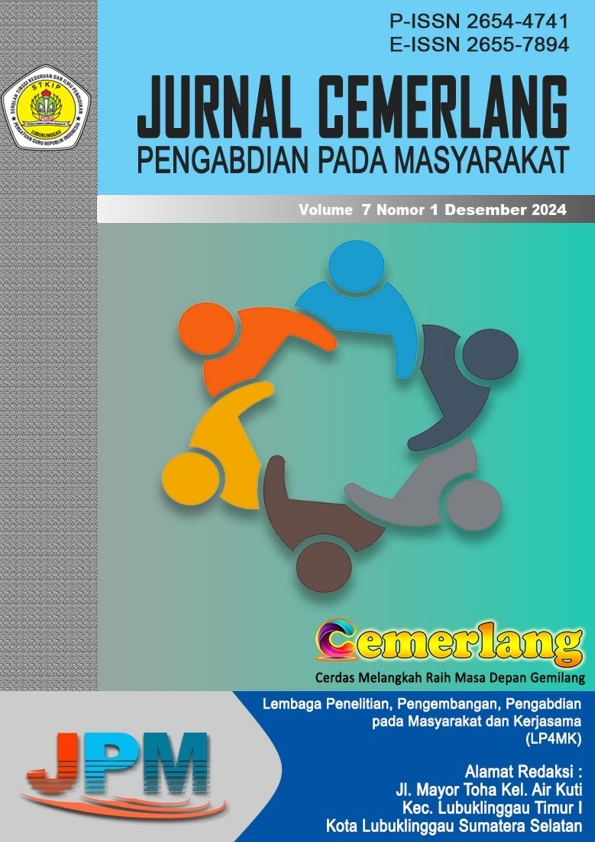Applying Viewing Techniques in Assisting Learning Listening The Students of Global Prestasi English Center
Abstract
English listening skill is widely considered fundamental as a basic for further mastering in English. A viewing technique changes into the most suitable option for assisting students in learning listening English. A community service program is implemented to teach listening by using viewing techniques for the students of Global Prestasi English Center. Students are treated with movie-viewing techniques. These include fast forward, silent viewing of language, English learners are assisted to boost listening skills, freeze frame, and partial viewing. It is carried out in fifteen meetings weekday timetable. Students’ responses for the levels of appropriateness are mostly appropriate and absolutely appropriate. These responses are a number student of 93.2% to recognize words meaning, 97.7% to enrich new vocabulary, 86,3% to identify expressions and ideas, 90,9% to improve pronunciation and spelling, 83,1% to recall important words, 81,8% to avoid similar sounds, 93,2% acknowledge to predict or confirm meaning, 93,2% distinguish between sounds, 72,7% understand native speaker accent, and 97,7% listening activity icebreaker.
References
Burhanuddin, B., Rosmiaty, R., & Fadilah, N. (2020). A correlative study on EFL students’ binge watching behaviors and their vocabulary mastery. ELT Worldwide: Journal of English Language Teaching, 7(2), 116–119. https://doi.org/10.26858/ELTWW.V7I2.15387.
Episiasi, E., Mujiyanto, j., Suwandi, & Hartono, R. (2023). Exploring the Effects of Metacognitive Strategy on EFL Students’ Listening Performance in Indonesia. New Educational Review, 72(2023), 176-187. https://doi.org/10.15804/tner.23.72.2.13
Hamidah, G. E., & Hadi, M. S. (2021). Enhancing listening comprehension through Frozen 2 movie. Journal of Languages and Language Teaching, 9(2), 139–149. https://doi.org/10.33394/JOLLT.V9I2.3530
Harmer, J. (2007). The practice of English language teaching. Harlow, UK: Pearson Education Ltd.
Hemei, J. (1997). Teaching with video in an English class. Journal of English Teaching Forum, 35(2), 45-47.
Kusumarasdyati. (2004). Listening, viewing and imagination: movies in EFL class. In the proceeding of the 2nd International Conference on Imagination and Education. (pp. 1-10), Monash University, Australia.
Sulistyowati, T. (2011). The impact of teaching listening comprehension by audio and audio picture aids on the 3rd semester students’ listening proficiencies of English education department students of Muria Kudus University in the academic year 2009/2010. Journal of social and culture,4(2). Retrieved from http://jurnal.umk.ac.id/?page_id=1556.
Richard, J. C. (2010). The language teaching matrix. Cambridge: Cambridge University Press.
Suramto (2019). Developing the Students’ English Listening Skills by Applying Drama Movies Viewing Techniques. ENGLISH FRANCA: Academic Journal of English Language and Education Vol. 3, No. 1, 2019.
Vagias, Wade M. (2006). Likert-type scale response anchors. Clemson International Institute for Tourism & Research Development, Department of Parks, Recreation and Tourism Management. Clemson University.
Watley, H. D. (2012). The effective use of motion pictures in the ESL classroom. Journal of Arts, Science & Commerce,3(2), 50-53.

Jurnal Pengabdian Masyarakat by http://ojs.stkippgri-lubuklinggau.ac.id/index.php/JPM is licensed under a Creative Commons Attribution-ShareAlike 4.0 International License.













